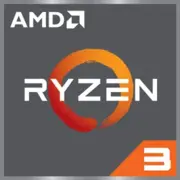AMD Ryzen 3 2200G with Radeon Vega 8 Graphics

AMD Ryzen 3 2200G with Radeon Vega 8 Graphics: Budget APU for Basic Tasks in 2025
Relevance, Features, and Build Recommendations
1. Key Specifications: Architecture and Main Features
The AMD Ryzen 3 2200G processor, released in 2018, remains a popular choice for ultra-budget builds thanks to its integrated graphics.
- Architecture: Zen (first generation) with integrated GPU Radeon Vega 8.
- Process Technology: 14 nm FinFET — an outdated standard for 2025, but sufficient for basic tasks.
- Cores and Threads: 4 cores / 4 threads. Base frequency — 3.5 GHz, up to 3.7 GHz in turbo mode.
- Cache: 4 MB L3.
- Graphics: Vega 8 with 8 compute units (512 stream processors) and a frequency up to 1100 MHz.
Key Features:
- Integrated graphics, allowing use without a discrete graphics card.
- Unlocked multiplier for overclocking (requires a motherboard with B450/X470 chipset and good cooling).
- Low power consumption (TDP 65 W).
Practical Example: In 2025, the APU is suitable for office PCs or home media centers. For instance, it can handle document work, stream 4K videos on YouTube, or run older games like CS:GO on low settings (40-60 FPS).
2. Compatible Motherboards
The Ryzen 3 2200G uses the AM4 socket, ensuring compatibility with many motherboards released between 2017 and 2023.
- Recommended Chipsets:
- A320/B350: Basic boards without overclocking support (A320) or with limited overclocking (B350). Example: ASUS Prime A320M-K ($50–$60).
- B450/X470: Optimal choice for overclocking and upgrading. For example, MSI B450 Tomahawk Max ($70–$90).
- A520/B550/X570: Compatible after a BIOS update, but excessive for the 2200G.
Selection Features:
- Ensure that the motherboard supports Raven Ridge processors (some older boards require a BIOS update).
- For cost savings, it's better to choose models with HDMI 2.0 for 4K output.
3. Supported Memory
- Type: DDR4 (DDR5 is not supported).
- Frequencies: Officially — up to 2933 MHz, but many boards allow overclocking to 3200–3400 MHz.
- Modes: Must use dual-channel configuration (2 modules of 4/8 GB). This improves the performance of Vega 8 by 20–30%.
Example: A pair of 8 GB DDR4-3200 modules (such as Crucial Ballistix) will cost around $40–$50.
4. Power Supply Recommendations
- Minimum Power: 350–400 W (for example, EVGA 400 BR, $35).
- Optimal Option: 450–500 W (Corsair CX450, $55) — headroom for future upgrade to a discrete graphics card at the level of GTX 1650.
Important: The power supply must have a 4-pin EPS connector for CPU power.
5. Pros and Cons
Pros:
- Low price ($50–$70 in 2025 for new units).
- Energy efficiency.
- Integrated graphics for less demanding gaming.
Cons:
- Outdated process technology (14 nm vs. 5–7 nm in modern APUs).
- Only 4 threads — weak multitasking.
- Vega 8 struggles with 2025 games even on low settings.
6. Use Cases
- Office Tasks: Browsing, office applications, video calls.
- Multimedia: Streaming 4K videos, editing simple clips in DaVinci Resolve (with basic effects).
- Games:
- Legendary Titles: Dota 2, GTA V, Overwatch — 720p/1080p, low settings.
- Indie Games: Hollow Knight, Stardew Valley — 60 FPS.
Real Experience: In tests from 2025, the APU shows 15–25 FPS in Cyberpunk 2077 (720p, minimum settings), making it unsuitable for modern AAA titles.
7. Comparison with Competitors
- AMD Ryzen 5 5600G ($120): 6 cores/12 threads, Vega 7 (but based on Zen 3 architecture). Performance is 2–3 times higher.
- Intel Core i3-12100 ($100): 4 cores/8 threads, UHD 730. Better in single-threaded tasks, but weaker in graphics.
- Budget APUs of 2025: For instance, Ryzen 3 8300G (Zen 4, RDNA 3) — twice as fast in games at a similar price.
Conclusion: The Ryzen 3 2200G is relevant only with a very limited budget ($200–$300 for the entire build).
8. Practical Assembly Tips
1. Memory: 2x8 GB DDR4-3200.
2. Storage: Use an SSD (for example, Kingston A400 480 GB, $30).
3. Cooling: The stock cooler is sufficient, but for overclocking consider the DeepCool Gammaxx 400 ($20).
4. Case: Mini-ITX for a compact media center (Cooler Master Elite 110, $50).
Sample Build:
- CPU: Ryzen 3 2200G ($60).
- Motherboard: ASRock B450M-HDV ($65).
- Memory: 16 GB DDR4-3200 ($45).
- SSD: 500 GB ($30).
- PSU: 450 W ($55).
- Case: $40.
Total: ~$295.
9. Final Conclusion: Who is Ryzen 3 2200G For?
This processor should only be considered in two cases:
1. Building a PC for basic tasks (office work, study, browsing) with a budget of up to $300.
2. Upgrading old systems (for example, replacing an Athlon X4 860K with an AM4 platform).
Alternative: If the budget allows adding $50–$70, it is better to get the Ryzen 5 4600G or Intel i3-13100 — they will provide performance headroom for 3–4 years.
Main Disadvantage in 2025: Lack of support for modern technologies (PCIe 4.0, DDR5, AI accelerators), making the APU a "dead-end" platform.
Conclusion: The Ryzen 3 2200G is an example of a "survivor" budget solution, but its time is coming to an end. It is suitable only for those willing to sacrifice performance for minimal cost.
Basic
CPU Specifications
Memory Specifications
GPU Specifications
Miscellaneous
Benchmarks
Compared to Other CPU
Share in social media
Or Link To Us
<a href="https://cputronic.com/index.php/cpu/amd-ryzen-3-2200g-with-radeon-vega-8-graphics" target="_blank">AMD Ryzen 3 2200G with Radeon Vega 8 Graphics</a>